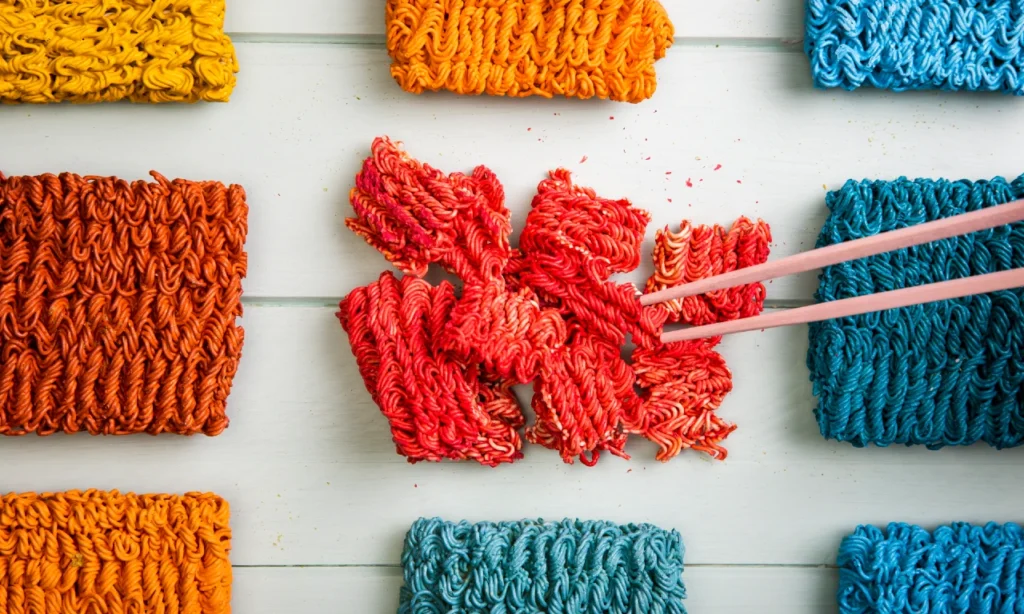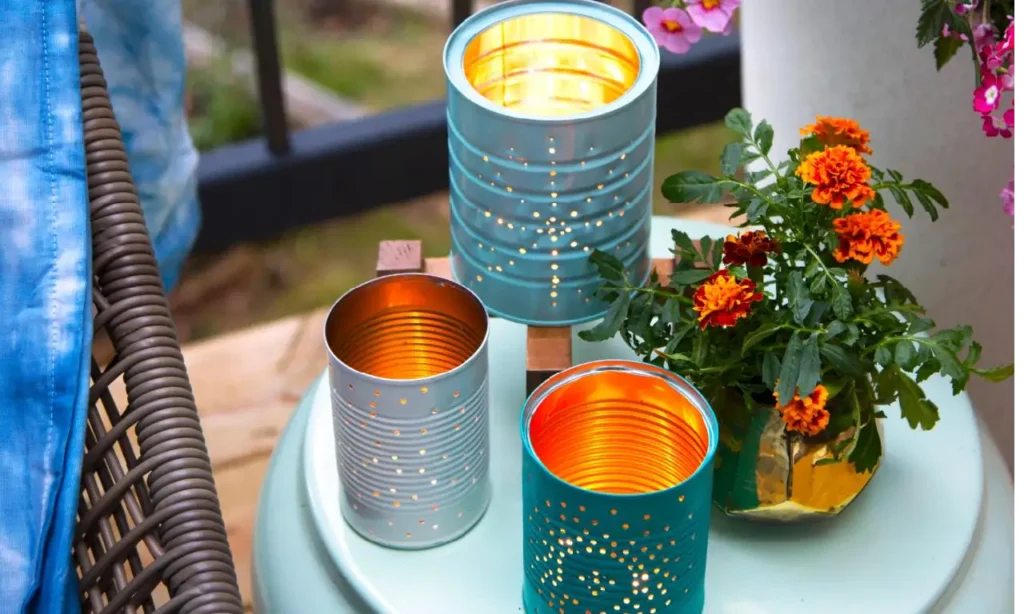Eco Printing Yarn with Bundle Dyeing Sometimes I get an idea in my head and I can’t seem to stop until I try in out. In this case, I had a vision of a delightful speckled yarn, dyed entirely with plants. So, of course, I spent a few hours in the dye lab after teaching one day and came up with this simple method for eco printing on yarn.
This post contains affiliate links. If you purchase something from these links I may make a small commission at no cost to you. See my full disclosure policy for details.
Related: Simple Crafts for Kids Using Household Items
What is Eco Printing?
Eco printing is a natural dyeing technique that uses plants to create patterns on textiles. Depending on the technique and materials, the patterns can be anything from abstract textures to clear imprints of leaves and flowers.
One of my favorite types of eco printing is bundle dyeing. In this technique, the fabric to be printed on is first prepared with a mordant (a chemical such as alum that helps bond the color to the fibers). Next, the plants are arranged over the fabric in the desired pattern or quantity. This is then rolled up and tied into a little bundle. This bundle is steamed for an hour or so, then left to cool. Once the bundle is opened, the plant matter is discarded and the fabric washed and dried. At this point the fabric is ready to use.
How is Eco Printing Yarn Different than Eco Printing Fabric?
The main reason that it isn’t possible to use this method unaltered to dye yarn is because, unless you’re using big, intact pieces of plant, it will make a mess. Removing little bits of wet plants after dyeing is not easy, especially if you’re using a grabby wool yarn. Marigolds are one of my favorite flowers to use when natural dyeing, and their tiny petals could easily become perminantly entangled. I don’t even want to think about what a headache it would be to pick out logwood chips!
So, I realize there needed to be a barrier of some sort between the yarn and the plant materials. Something that would allow the color to seep through while at the same time keeping the plants separate from the yarn.
How I Eco Printed my Yarn
Below is the exact process I used to make this speckled yarn. I’ve tried to include as many details as possible, but a passing knowledge of natural dyeing and/or yarn handling will defiantly help. That said, it’s hard to go too wrong here, so don’t be afraid to try this even if you’re a beginner!
Also, I would have included more images, but at the moment I can’t take pics in the dye space I use. It’s not ideal, but I hope you understand!
Supplies
- Yarn – I used Knomad Marshmallow Worsted. You’ll want this in hank format, not in a ball or skien.
- Alum – For my mordant, I chose to use alum at 12% Weight of Fiber (WOF) for wool. If you’re using a different fiber you may need a different type or amount of mordant. If I’m not sure about something like that, my favorite resource is the book The Art and Science of Natural Dye by Joy Boutrup and Catharine Ellis (Amazon.com / Bookshop.org)
- String – Any undyed string will work here as long as you can tie it tightly. I tend to reach for a cotton crochet yarn.
Tools
- Small scale – Ideally a scale that is accurate down to 0.1 gram. This is for measuring the weight of our fiber as well as the alum.
- Small spoon – for measuring out the alum. You may also want a small bowl or a piece of paper to protect your scale.
- A smooth plastic or metal spoon – for managing your yarn while mordanting. A wooden spoon will work in a pinch, just pay careful attention so it doesn’t snag on your yarn.
- Gloves – Use gloves to protect your hands through out this process. I like to wear over the elbow gloves so I don’t have to worry about splashes.
- Mask – You’ll need a mask when weighing out your alum. I use a KF-94 because that’s what I generally keep on hand. A full respirator is better, but at minimum make sure you’re wearing some kind of protection.
- Safety Glasses – Ok, I generally forget to put mine on, but I do recommend using safety glasses to protect your eyes from errant splashes.
Mordanting
The first part of the process is to mordant your yarn. This allows the dyes from the plants to form strong bonds with your fiber. Without this process, the color may not stick at all, or will only stain the yarn, forming a very weak bond.
- Weigh your yarn: In order to know how much alum to use, you need to know how much your fiber weighs. I like to use grams for this, because it’s so much easier to calculate. So, using your scale, weigh the yarn and write that number down.
- Dissolve alum and add to big pot of water: At this point, I like to fill my big pot with water and dissolve my alum in that. You can also dissolve the alum separately in your small bowl. The most important thing is that the alum is fully dissolved before you add the yarn.
- Simmer yarn: Add the yarn to your pot then bring to a simmer for about an hour. I like to keep my pot between 190f and 200f. Move your yarn occasionally, to avoid scorching, but don’t stir. I like to use the same up and down motion that I use to detangle the yarn when taking it out of the bucket.
- Remove yarn from pot: One hank at a time, remove the yarn from the pot and gently squeeze out the excess water. The yarn should still be quite damp, but not dripping.
Bundle Dyeing the Yarn
- Add your dyestuff: Sprinkle your dyestuff over your cheese cloth covered yarn. How exactly you do this is entirely up to you. The more you add, the more dye will be transferred onto the yarn. This is very much about trial and error, as each plant spreads and takes at different rates.
- Roll up your bundle: The goal here is to roll up the yarn/cheesecloth/dyestuff into a tight bundle, pressing all the layers together. There’s really no wrong way to do this as long as all three parts stay together and in order. I rolled mine into log, then curled it into a spiral. Secure it with string in any manner that works for you.
- Remove from the steamer and let cool: Using your tongs, take the yarn bundles out of the steamer and set somewhere to cool. I usually let them cool overnight, which allows the dye to set even more. Just don’t let them sit longer than 24 hours as you may start to have microbe growth.
Cleaning and Finishing the Eco Printed Yarn
- Carefully unroll your bundles: The goal here is to separate the yarn from the cheese cloth without getting the dyestuff all over it. The spent dyestuff should be disposed of, but if you can get most of it off your cheese cloth, that can be washed and reused in other dyeing and craft projects.
- Gently wash the yarn: I add a small amount of wool wash or shampoo to a large bucket of room temperature water. I then gently swish my yarn a few times and check the color of the water. If the water is mostly clear, you’re fine to rinse. If not, let the yarn soak a bit, change the water, and try again. Your goal here is to get any excess dye and alum out of the yarn.
Note: It’s completely normal for your yarn to shift colors during washing or rising. Many natural dyes are very pH sensitive. Sometimes these changes can be reversed by treating the yarn with a solution of the opposite pH. For example, water mixed with vinegar or citric acid can cause colors to become warmer. This is also fun to play around with on purpose! - Rinse the yarn: Use plain room temperature water for one final rinse to get any soap out of the yarn.
- Remove excess water: In order for the yarn to dry in a timely fashion, excess water needs to be removed. You can do this one of two ways: with a towel or a washing machine. If using a towel, roll the yarn up in the towel and press gently to force excess water from the yarn into the towel, then move on to the next step.
- Dry the yarn: Air dry your yarn on a rack for a day or so. The yarn should be completely dry before you store it, so leave it out as long as you need to.
Using Your Eco Printed Yarn
Once the yarn is dry, it’s ready to be used or stored however you like! The yarn shouldn’t have issues with crocking or dye transfer and the texture shouldn’t have changed significantly. However, just to be safe I always swatch after dyeing.
However, it’s important to remember that natural dyes don’t always behave exactly like commercial yarns. Some colors will fade more quickly than others in light, while others may be more sensitive to washing. There also is a risk of color shifting if it’s exposed to high or low pH during cleaning. This can come from the water its self or from the detergent or other additives used for washing. I just see this as a natural part of the process and try to embrace it, but if you use a process like this on something you intend to gift or sell, defiantly include a note or care card.
Personally, I’m pretty pleased with the way my eco printed yarn turned out. I ended up with a gently speckled but mostly white yarn using only plants for dyes. Additionally, I think that there is defiantly room to play with this technique more. I’d love to see how things turn out if I simmer, rather than steam the yarn. It would also be fun to layer this over other natural (or synthetic!) dyes. And of course there is no end to the different plants it would be fun to try.




